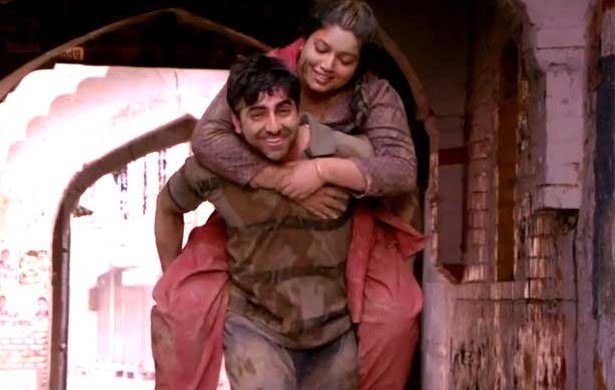Sharat Katariya’s Dum Laga Ke Haisha has seriously raised the bar for female representation as well as for thoughtful and sensitive character developments for male leads in Bollywood films. I have watched this film several times and finally decided that it was too significant to not write about. Read this spoiler-filled semi-review, semi-love letter and complete feminist review to the film at your own risk.
I have always been slightly critical of the body-positivity movement. In its commercialised form – you know the one, it tries to sell you the crux of your liberation: plus-size lingerie – it focuses singularly on self-acceptance. It puts the pressure of emancipation on the victim of discrimination, conveniently ignoring the role that cultural processes play in creating that environment of prejudice. Dum Laga ke Haisha steers clear of this conventional route through the sheer delight that was Bhumi Padnekar’s character, the overweight Sandhya and the character development that Ayushman Khurana’s Prem would undergo.
It was so utterly refreshing to see a female lead that doesn’t suffer from body-image issues, especially when the rest of her community – particularly her husband – wants her to. Throughout the story, Sandhya remained unapologetic about and completely content with her size. Sandhya’s acceptance of her appearance allows her to deal with external agents that want her to feel insecure. When Prem is shown staring longingly after a couple of thin and blonde women, Sandhya patiently reminds him of his promise of fidelity to her. Her cheeky “Look your fill, I’ll wait” accurately shames Prem’s roving eye; the director should be commended for not taking the conventional route of showcasing women putting each other down and competing for male attention.
It is not enough for us to simply rejoice in Sandhya, it is important that we demand a better attitude towards and treatment of her from the community.
Crucially, Kataria doesn’t stop here. It is not enough for us to simply rejoice in Sandhya, it is important that we demand a better attitude towards and treatment of her from the community. In the process of delivering one of the most interesting character arcs – in my opinion – for a male lead in Hindi cinema Dum Laga Ke Haisha delivers exactly this. Kataria quite subtly, yet masterfully, mocks the patriarchal desire to fat-shame, revealing it (in this instance) as stemming from one’s own insecurities.
Just think about it. At the core of Prem’s chauvinistic behaviour towards Sandhya lie long-held feelings of inadequacy. After all, Prem is a Class X dropout and working in an obsolete industry; his financial status so weak that the family choose a bride for him based on her superior economic prospects. Prem compensates for his failures through his association with the RSS, the hypermasculine influence goading on Prem’s misplaced sense of entitlement and encouraging the bad behaviour towards his wife. Prem resents Sandhya’s confidence and education and agency, lashing out to try and arouse the same levels of insecurity in her.
Also read: The Conundrum Of Being A Sanjay Leela Bhansali Heroine
Eventually, Prem has to acknowledge that his life is in shambles. His family business is being threatened, he’s been ousted by the RSS, Sandhya has filed for a divorce and certain he’s failed his English exam. It is in this moment that Prem abandons his misplaced superiority complex; apologising to Sandhya upon realising that he is not worthy of her care and affection. Another crucial aspect of Prem’s character arc is that it was not love that gave way to respect, but respect that gave way to love.
Another crucial aspect of Prem’s character arc is that it was not love that gave way to respect, but respect that gave way to love.
Ah, two complex and unconventional protagonists. Whatever shall we do to make them to cement their love for each other? Using heavy symbolism through the titular character: the extremely peculiar wife-lifting-obstacle-course. It’s easy to be dismissive of the ‘Dum Laga Ke Haisha’ competition, since it is essentially about the irony of the husband with the heaviest wife winning because love conquers all. Right?
Except, it’s more than that. Women, particularly in Indian media, are often portrayed as the ones who bear the responsibility of accommodating themselves to the expectations of their husbands, their in-laws, their communities. To have the man of the relationship carrying the literal and figurative weight – pardon the pun – of the relationship is quite a rare sight, whether it is on TV or film. Sandhya’s cautiously optimistic “Will you be able to do this?” directed at Prem, when he encounters a particularly difficult hurdle, perfectly encapsulates the story’s desire to raise the bar for men.
To me it felt as through this message transcends the weight aspect of the story.
But…
- What if our leads hadn’t won the competition?
- What if Prem hadn’t been such a failure and his family were in a better financial situation?
- Does Dum Laga Ke Haisha only suggest that those who have their own issues must refrain from fat-shaming?
- Can we surmise a thoroughly constructed and, dare I say it, an instructive feminist position from a single story?
Also read: Bollywood Needs More Fat Heroines Now!
These questions arise because of the lack of plus-size female lead characters and stories created by and for them in Hindi cinema. The burden to deliver the perfect and most wholesome message about body positivity cannot fall upon the shoulders of a single story, and all critique – both praise and disapproval – must be mindful of this. Dum Laga ke Haisha is undoubtedly ground-breaking and, with any luck, it will pave the way for more inclusive stories from the Hindi film industry.
Featured Image Source: MoiFightClub
About the author(s)
Richa is talkative, argumentative but, above all, loves all things feminism.




